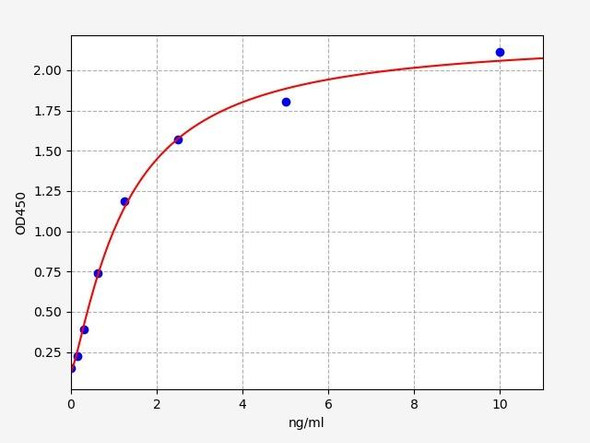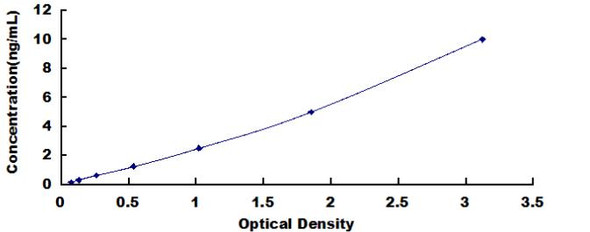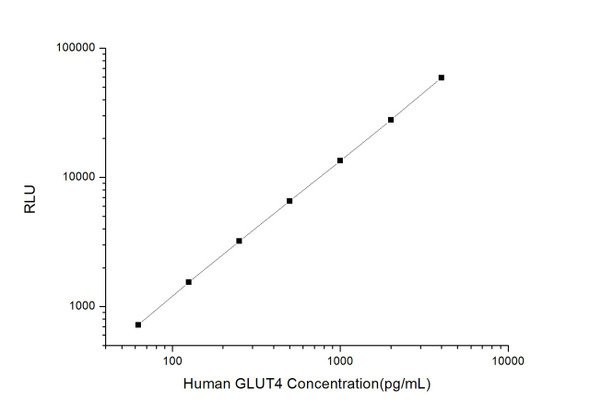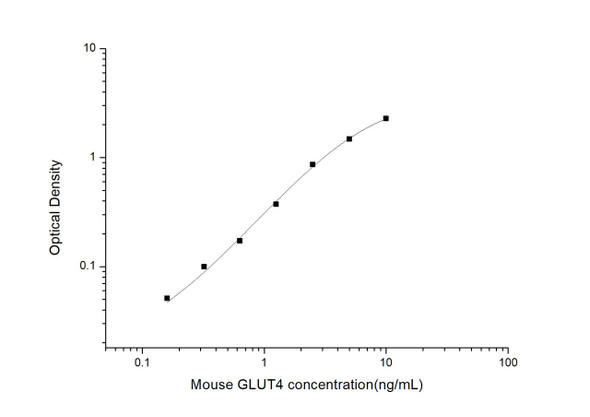Mouse Cell Signalling ELISA Kits 5
Mouse GLUT4 (Glucose Transporter 4) CLIA Kit (MOES00296)
- SKU:
- MOES00296
- Product Type:
- ELISA Kit
- ELISA Type:
- CLIA Kit
- Size:
- 96 Assays
- Sensitivity:
- 18.75pg/mL
- Range:
- 31.25-2000pg/mL
- ELISA Type:
- Sandwich
- Reactivity:
- Mouse
- Sample Type:
- Serum, plasma and other biological fluids
- Research Area:
- Signal Transduction
Description
| Assay type: | Sandwich |
| Format: | 96T |
| Assay time: | 4.5h |
| Reactivity: | Mouse |
| Detection method: | Chemiluminescence |
| Detection range: | 31.25-2000 pg/mL |
| Sensitivity: | 18.75 pg/mL |
| Sample volume: | 100µL |
| Sample type: | Serum, plasma and other biological fluids |
| Repeatability: | CV < 15% |
| Specificity: | This kit recognizes Mouse GLUT4 in samples. No significant cross-reactivity or interference between Mouse GLUT4 and analogues was observed. |
This kit uses Sandwich-CLIA as the method. The micro CLIA plate provided in this kit has been pre-coated with an antibody specific to Mouse GLUT4. Standards or samples are added to the appropriate micro CLIA plate wells and combined with the specific antibody. Then a biotinylated detection antibody specific for Mouse GLUT4 and Avidin-Horseradish Peroxidase (HRP) conjugate are added to each micro plate well successively and incubated. Free components are washed away. The substrate solution is added to each well. Only those wells that contain Mouse GLUT4, biotinylated detection antibody and Avidin-HRP conjugate will appear fluorescence. The Relative light unit (RLU) value is measured spectrophotometrically by the Chemiluminescence immunoassay analyzer. The RLU value is positively associated with the concentration of Mouse GLUT4. The concentration of Mouse GLUT4 in the samples can be calculated by comparing the RLU of the samples to the standard curve.
| UniProt Protein Function: | GLUT4: an integral membrane facilitative glucose transporter. One of 13 members of the human equilibrative glucose transport protein family. Its surface expression is regulated by insulin. Has two internalization sequences, a dileucine repeat present in the C-terminus and a FxxY motif in the amino-terminal end. Associates with an intracellular tubulo-vesicular compartment under low plasma conditions. The binding of insulin to the insulin receptor (a typosine kinase) leads to the rapid translocation of GLUT4 to the cell surface, increasing cellular glucose transport activity. Its translocation to the plasma membrane is also stimulated by exercise, but independent from insulin signaling. This insulin-independent pathway may be regulated by AMPK. |
| UniProt Protein Details: | Protein type:Membrane protein, multi-pass; Transporter; Membrane protein, integral; Transporter, SLC family Cellular Component: cell surface; clathrin-coated vesicle; coated pit; cytoplasm; cytoplasmic vesicle membrane; cytosol; endomembrane system; endosome; external side of plasma membrane; integral to membrane; integral to plasma membrane; intracellular membrane-bound organelle; lipid raft; membrane; multivesicular body; perinuclear region of cytoplasm; plasma membrane; sarcolemma; T-tubule; trans-Golgi network transport vesicle; vesicle; vesicle membrane Molecular Function:D-glucose transmembrane transporter activity; glucose transmembrane transporter activity; insulin-responsive hydrogen:glucose symporter activity; protein binding; substrate-specific transmembrane transporter activity; transmembrane transporter activity; transporter activity Biological Process: amylopectin biosynthetic process; brown fat cell differentiation; carbohydrate transport; cellular response to insulin stimulus; glucose homeostasis; glucose transport; transmembrane transport; transport |
| UniProt Code: | P14142 |
| NCBI GenInfo Identifier: | 341941082 |
| NCBI Gene ID: | 20528 |
| NCBI Accession: | P14142. 3 |
| UniProt Secondary Accession: | P14142,Q3TPK6, Q9JJN9, |
| UniProt Related Accession: | P14142 |
| Molecular Weight: | 54,755 Da |
| NCBI Full Name: | Solute carrier family 2, facilitated glucose transporter member 4 |
| NCBI Synonym Full Names: | solute carrier family 2 (facilitated glucose transporter), member 4 |
| NCBI Official Symbol: | Slc2a4 |
| NCBI Official Synonym Symbols: | Glut4; Glut-4 |
| NCBI Protein Information: | solute carrier family 2, facilitated glucose transporter member 4 |
| UniProt Protein Name: | Solute carrier family 2, facilitated glucose transporter member 4 |
| UniProt Synonym Protein Names: | GT2; Glucose transporter type 4, insulin-responsive; GLUT-4 |
| UniProt Gene Name: | Slc2a4 |
| UniProt Entry Name: | GTR4_MOUSE |
As the RLU values of the standard curve may vary according to the conditions of the actual assay performance (e. g. operator, pipetting technique, washing technique or temperature effects), the operator should establish a standard curve for each test. Typical standard curve and data is provided below for reference only.
| Concentration (pg/mL) | RLU | Average | Corrected |
| 2000 | 50834 60608 | 55721 | 55693 |
| 1000 | 23844 24104 | 23974 | 23946 |
| 500 | 11553 10511 | 11032 | 11004 |
| 250 | 5061 5527 | 5294 | 5266 |
| 125 | 2640 2576 | 2608 | 2580 |
| 62.5 | 1341 1281 | 1311 | 1283 |
| 31.25 | 652 696 | 674 | 646 |
| 0 | 27 29 | 28 | -- |
Precision
Intra-assay Precision (Precision within an assay): 3 samples with low, mid range and high level Mouse GLUT4 were tested 20 times on one plate, respectively.
Inter-assay Precision (Precision between assays): 3 samples with low, mid range and high level Mouse GLUT4 were tested on 3 different plates, 20 replicates in each plate.
| Intra-assay Precision | Inter-assay Precision | |||||
| Sample | 1 | 2 | 3 | 1 | 2 | 3 |
| n | 20 | 20 | 20 | 20 | 20 | 20 |
| Mean (pg/mL) | 108.36 | 310.94 | 957.92 | 97.78 | 306.79 | 1005.42 |
| Standard deviation | 12.91 | 22.36 | 93.68 | 11.79 | 24.21 | 103.06 |
| C V (%) | 11.91 | 7.19 | 9.78 | 12.06 | 7.89 | 10.25 |
Recovery
The recovery of Mouse GLUT4 spiked at three different levels in samples throughout the range of the assay was evaluated in various matrices.
| Sample Type | Range (%) | Average Recovery (%) |
| Serum (n=5) | 86-102 | 93 |
| EDTA plasma (n=5) | 96-112 | 103 |
| Cell culture media (n=5) | 90-105 | 98 |
Linearity
Samples were spiked with high concentrations of Mouse GLUT4 and diluted with Reference Standard & Sample Diluent to produce samples with values within the range of the assay.
| Serum (n=5) | EDTA plasma (n=5) | Cell culture media (n=5) | ||
| 1:2 | Range (%) | 101-118 | 89-100 | 89-101 |
| Average (%) | 109 | 94 | 95 | |
| 1:4 | Range (%) | 96-110 | 92-104 | 96-112 |
| Average (%) | 103 | 97 | 103 | |
| 1:8 | Range (%) | 85-97 | 100-117 | 87-103 |
| Average (%) | 90 | 107 | 94 | |
| 1:16 | Range (%) | 96-110 | 89-101 | 99-114 |
| Average (%) | 102 | 95 | 105 |
An unopened kit can be stored at 4°C for 1 month. If the kit is not used within 1 month, store the items separately according to the following conditions once the kit is received.
| Item | Specifications | Storage |
| Micro CLIA Plate(Dismountable) | 8 wells ×12 strips | -20°C, 6 months |
| Reference Standard | 2 vials | |
| Concentrated Biotinylated Detection Ab (100×) | 1 vial, 120 µL | |
| Concentrated HRP Conjugate (100×) | 1 vial, 120 µL | -20°C(shading light), 6 months |
| Reference Standard & Sample Diluent | 1 vial, 20 mL | 4°C, 6 months |
| Biotinylated Detection Ab Diluent | 1 vial, 14 mL | |
| HRP Conjugate Diluent | 1 vial, 14 mL | |
| Concentrated Wash Buffer (25×) | 1 vial, 30 mL | |
| Substrate Reagent A | 1 vial, 5 mL | 4°C (shading light) |
| Substrate Reagent B | 1 vial, 5 mL | 4°C (shading light) |
| Plate Sealer | 5 pieces | |
| Product Description | 1 copy | |
| Certificate of Analysis | 1 copy |
- Set standard, test sample and control (zero) wells on the pre-coated plate and record theirpositions. It is recommended to measure each standard and sample in duplicate. Note: addall solutions to the bottom of the plate wells while avoiding contact with the well walls. Ensuresolutions do not foam when adding to the wells.
- Aliquot 100µl of standard solutions into the standard wells.
- Add 100µl of Sample / Standard dilution buffer into the control (zero) well.
- Add 100µl of properly diluted sample (serum, plasma, tissue homogenates and otherbiological fluids. ) into test sample wells.
- Cover the plate with the sealer provided in the kit and incubate for 90 min at 37°C.
- Aspirate the liquid from each well, do not wash. Immediately add 100µL of BiotinylatedDetection Ab working solution to each well. Cover the plate with a plate seal and gently mix. Incubate for 1 hour at 37°C.
- Aspirate or decant the solution from the plate and add 350µL of wash buffer to each welland incubate for 1-2 minutes at room temperature. Aspirate the solution from each well andclap the plate on absorbent filter paper to dry. Repeat this process 3 times. Note: a microplatewasher can be used in this step and other wash steps.
- Add 100µL of HRP Conjugate working solution to each well. Cover with a plate seal andincubate for 30 min at 37°C.
- Aspirate or decant the solution from each well. Repeat the wash process for five times asconducted in step 7.
- Add 100µL of Substrate mixture solution to each well. Cover with a new plate seal andincubate for no more than 5 min at 37°C. Protect the plate from light.
- Determine the RLU value of each well immediately.






